The Hydraulic Dosing Pump Market is estimated to be valued at USD 3.0 billion in 2025 and is projected to reach USD 4.5 billion by 2035, registering a compound annual growth rate (CAGR) of 4.0% over the forecast period. Inflection point mapping reveals key transitions in growth patterns over the forecast period. Between 2025 and 2030, the market grows from USD 3.0 billion to USD 3.8 billion, contributing USD 0.8 billion in growth, with a CAGR of 4.9%.
This early-stage acceleration is driven by rising demand across industries such as water treatment, chemical processing, and pharmaceuticals, where precise chemical dosing and flow control are critical. The first inflection point occurs in 2030, when the market reaches USD 3.8 billion, marking a shift toward more stable growth. From 2030 to 2035, the market expands from USD 3.8 billion to USD 4.5 billion, adding USD 0.7 billion in growth, with a slower CAGR of 3.4%.
This deceleration reflects the market stabilizing as the adoption of hydraulic dosing pumps becomes widespread across industrial applications. The second inflection point marks the maturity phase, where growth becomes more incremental, driven by factors such as the replacement of aging equipment and incremental improvements in pump efficiency. The overall analysis indicates strong early-stage growth followed by a more stable and mature phase, with the market continuing to expand but at a more gradual pace.

| Metric | Value |
|---|---|
| Hydraulic Dosing Pump Market Estimated Value in (2025 E) | USD 3.0 billion |
| Hydraulic Dosing Pump Market Forecast Value in (2035 F) | USD 4.5 billion |
| Forecast CAGR (2025 to 2035) | 4.0% |
The hydraulic dosing pump market is witnessing robust expansion, fueled by rising investments in water and wastewater treatment infrastructure, chemical processing plants, and food and beverage manufacturing. The growing need for accurate, consistent fluid dosing in critical processes has led industries to adopt highly reliable and efficient dosing technologies.
Advancements in hydraulic actuation mechanisms, combined with digitally controlled flow regulation, are enabling pumps to handle corrosive, high-viscosity, and abrasive fluids with minimal maintenance. Industrial automation and increased process safety requirements are encouraging the use of dosing pumps with programmable logic controls and integrated diagnostics.
Government regulations around effluent quality and process standardization are further accelerating demand, particularly in sectors such as oil and gas, power generation, and pharmaceuticals. Future growth is expected to be supported by the integration of IoT-based monitoring, energy-efficient designs, and modular pump systems, allowing scalability and flexibility in both centralized and decentralized operations across developed and emerging markets.
The hydraulic dosing pump market is segmented by pump type, capacity, control type, application, and geographic regions. By pump type, the hydraulic dosing pump market is divided into Diaphragm Dosing Pumps, Plunger Dosing Pumps, and Peristaltic Dosing Pumps. In terms of capacity, the hydraulic dosing pump market is classified into Medium Capacity (100–1000 ml/min), Low Capacity (100 ml/min), and High Capacity (>1000 ml/min). Based on the control type, the hydraulic dosing pump market is segmented into Fully Automatic Control, Manual Control, and Semi-Automatic Control. By application, the hydraulic dosing pump market is segmented into Water and Wastewater Treatment, Chemical Processing, Pharmaceutical and Biotechnology, Food and Beverage. Regionally, the hydraulic dosing pump industry is classified into North America, Latin America, Western Europe, Eastern Europe, Balkan & Baltic Countries, Russia & Belarus, Central Asia, East Asia, South Asia & Pacific, and the Middle East & Africa.
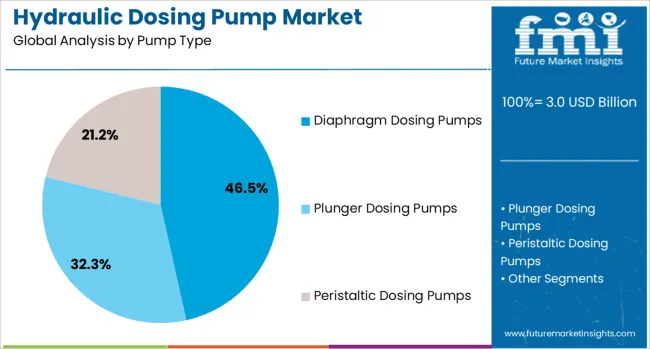
Diaphragm dosing pumps are projected to account for 46.5% of the hydraulic dosing pump market revenue in 2025, making it the leading pump type in terms of adoption. This dominance is being driven by their superior capability to handle corrosive and abrasive chemicals while maintaining a leak-free operation. The absence of dynamic seals and the presence of flexible diaphragms ensure safe handling of hazardous liquids, making them highly suitable for chemical dosing applications.
These pumps offer precise and pulsation-free flow, reducing risks in pressure-sensitive environments. Their compatibility with aggressive fluids, minimal maintenance requirements, and long operational lifespan are contributing to widespread usage across industries such as water treatment, petrochemicals, and pharmaceuticals.
Additionally, diaphragm pumps have gained preference due to their suitability for automated control systems and ease of integration with digital dosing controllers. The cost-effectiveness in high-duty operations and enhanced safety features have reinforced their position as the preferred pump type in hydraulic dosing applications.
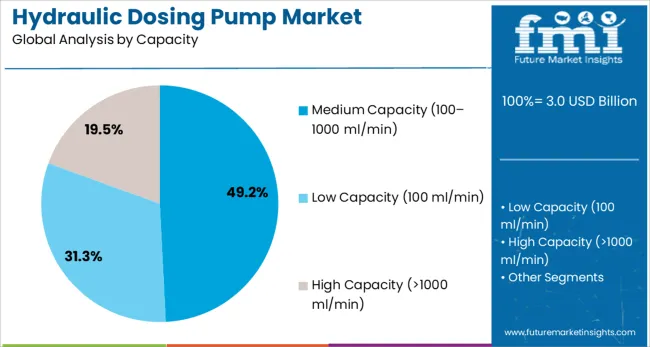
The medium capacity segment is expected to account for 49.2% of the total revenue share in the hydraulic dosing pump market in 2025, reflecting its high utility across various industrial dosing applications. This capacity range is considered ideal for operations requiring moderate yet precise dosing rates, especially in water purification, boiler feed applications, and chemical treatment cycles.
The segment's dominance is supported by its balance between operational efficiency and dosing accuracy, making it suitable for both batch and continuous processes. Medium capacity pumps are being increasingly adopted in small and medium-scale industries due to their ability to handle varied flow demands without compromising on dosing precision.
The scalability and adaptability of these pumps to diverse chemical compositions, as well as their compatibility with modern control systems, have made them a reliable choice. Their widespread deployment in municipal and industrial water treatment units, driven by cost efficiency and performance stability, has further reinforced their market leadership.
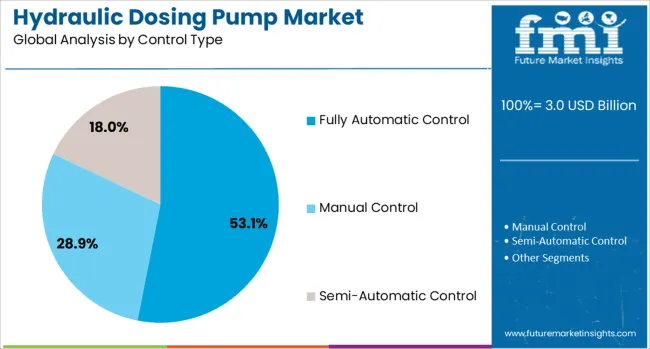
The fully automatic control segment is anticipated to hold 53.1% of the total revenue in the hydraulic dosing pump market by 2025, emerging as the most dominant control type. This leadership is being influenced by the rising demand for intelligent dosing systems that offer real-time adjustments, process optimization, and minimal human intervention.
Fully automatic pumps are being favored for their integration with SCADA and PLC-based control frameworks, allowing seamless monitoring, fault detection, and remote diagnostics. Industries such as pharmaceuticals, food and beverage, and power generation are increasingly investing in automation to enhance process safety, reduce manual error, and comply with regulatory standards.
The use of sensors, flow meters, and adaptive control algorithms in these systems enables consistent dosing even under fluctuating pressure and temperature conditions. As industries transition toward smart manufacturing and digital process management, the demand for fully automatic hydraulic dosing pumps is expected to remain high, driven by productivity gains, reduced downtime, and superior dosing consistency.
The hydraulic dosing pump market is growing due to the increasing demand for precise fluid dosing solutions across industries like water treatment, chemicals, pharmaceuticals, and food processing. These pumps offer high accuracy, reliability, and efficiency, making them ideal for applications requiring precise chemical dosing and fluid control. As industries focus on automation and process optimization, the market for hydraulic dosing pumps is expanding. Despite challenges such as high installation and maintenance costs, advancements in pump design and increased adoption of automation are contributing to market growth.
The hydraulic dosing pump market is primarily driven by the increasing need for accurate fluid control in various industrial applications. These pumps are essential for precise dosing in industries such as water treatment, chemicals, and pharmaceuticals, where the accurate mixing of fluids is critical for product quality and safety. The ability to handle a wide range of viscosities and pressures makes hydraulic dosing pumps ideal for applications where precision and reliability are essential. The growing emphasis on process automation and the demand for optimized production processes further accelerates the adoption of hydraulic dosing pumps across various sectors, particularly in industries focused on high-volume and continuous production.
A significant challenge in the hydraulic dosing pump market is the high initial cost of purchasing and installing these systems, particularly for large-scale industrial applications. These pumps require significant investment, especially in industries with complex fluid dosing requirements. Hydraulic dosing pumps often require regular maintenance and servicing to ensure optimal performance. The need for specialized technicians, spare parts, and periodic calibration adds to operational costs. Furthermore, ensuring the longevity and reliability of these pumps in harsh operating conditions can pose challenges for industries with limited resources for maintenance and troubleshooting, slowing market adoption.
The hydraulic dosing pump market offers numerous opportunities driven by advancements in pump technology and the growing demand for precision in fluid control applications. Innovations in pump design, such as enhanced seals, more durable materials, and advanced monitoring systems, are improving pump performance and reducing maintenance costs. The rise in industrial automation and IoT integration opens opportunities for more efficient, real-time dosing systems that optimize chemical use and reduce waste. The expanding applications in emerging markets and the growing adoption of water treatment solutions provide significant growth prospects for hydraulic dosing pumps, especially in industries aiming for greater process efficiency and sustainability.
A prominent trend in the hydraulic dosing pump market is the increasing integration of automation and remote monitoring technologies. The rise of Industry 4.0 has driven the development of smart dosing pumps that can be monitored and controlled remotely, enabling real-time adjustments and optimization of fluid dosing. This trend allows for greater accuracy, improved energy efficiency, and enhanced process control. The integration of digital sensors and IoT technology enables predictive maintenance, helping to prevent pump failures and reduce downtime. This trend towards smarter, more efficient pumps is expected to drive further growth in the hydraulic dosing pump market, especially in industries focused on reducing operational costs and improving production efficiency.
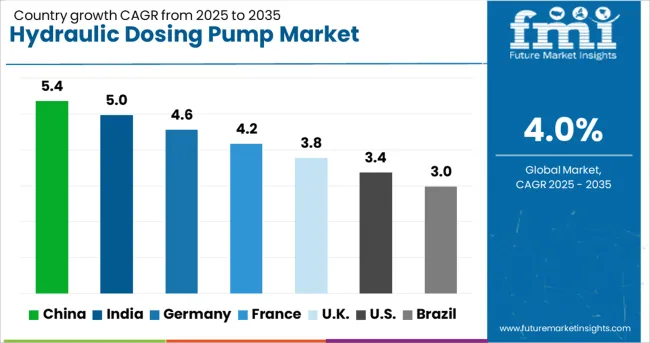
| Country | CAGR |
|---|---|
| China | 5.4% |
| India | 5.0% |
| Germany | 4.6% |
| France | 4.2% |
| UK | 3.8% |
| USA | 3.4% |
| Brazil | 3.0% |
The global hydraulic dosing pump market is expected to grow at a CAGR of 4.1% from 2025 to 2035. China leads with a growth rate of 5.4%, followed by India at 5.0%. France is projected to grow at 4.2%, while the UK and USA are seeing moderate growth rates of 3.8% and 3.4%, respectively. The increasing demand across various industries such as water treatment, chemicals, and pharmaceuticals is driving the market. The rise in industrial automation and growing focus on efficiency and precision in fluid management further contribute to the market’s expansion The analysis includes over 40 countries, with the top five detailed below.
The hydraulic dosing pump market in China is growing at a CAGR of 5.4%. The demand is largely driven by the country’s rapid industrialization and expanding sectors like water treatment, chemicals, and pharmaceuticals. As China continues to focus on enhancing its infrastructure and manufacturing capabilities, the need for precise fluid handling and dosing systems increases.The government’s investment in environmental protection and water treatment facilities is driving the demand for hydraulic dosing pumps in sectors such as wastewater treatment. The country’s growing chemical and pharmaceutical industries are also significant contributors to the rising adoption of dosing pumps.
The hydraulic dosing pump market in India is projected to grow at a CAGR of 5.0%. The country’s increasing focus on industrial development, especially in sectors like water treatment, pharmaceuticals, and chemicals, is driving the demand for dosing pumps. India’s need for effective fluid management in its rapidly growing industrial base is increasing the adoption of hydraulic dosing pumps, particularly in chemical dosing applications. The rising awareness of water treatment and the government’s initiatives to improve water quality and sanitation further contribute to the market’s growth. As India’s pharmaceutical and chemical industries expand, the demand for efficient and reliable dosing systems continues to rise.

The hydraulic dosing pump market in France is expected to grow at a CAGR of 4.2%. The country’s increasing demand for high-precision fluid management systems in industries like chemicals, pharmaceuticals, and water treatment is driving this growth. France’s commitment to improving water quality and environmental standards is fueling the adoption of hydraulic dosing pumps, particularly in wastewater treatment applications. The pharmaceutical industry’s need for accurate and efficient dosing systems in manufacturing processes is also contributing to the demand. With continued advancements in automation and precision in fluid handling, The market for hydraulic dosing pumps is expected to expand steadily.
The UK’s hydraulic dosing pump market is expected to grow at a moderate CAGR of 3.8%. The increasing adoption of automation in industrial processes, particularly in water treatment and chemical industries, is driving demand for hydraulic dosing pumps. The country’s strong regulatory framework for water quality management and wastewater treatment further supports the growth of the market. The UK’s pharmaceutical and chemical sectors are also driving the demand for accurate and efficient fluid dosing systems. As industries focus more on efficiency and reducing waste, the need for reliable dosing solutions continues to grow across various sectors.
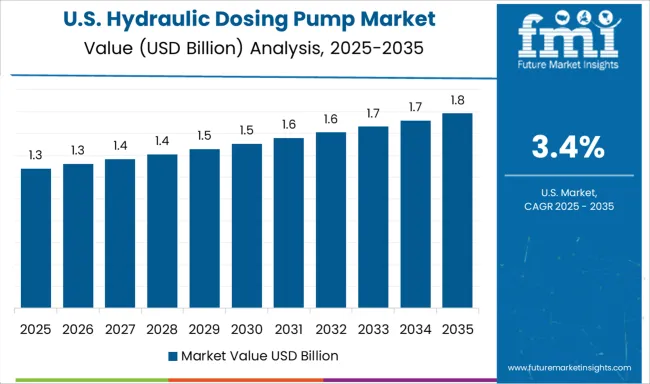
The USA hydraulic dosing pump market is projected to grow at a CAGR of 3.4%. The demand is primarily driven by the country’s industrial base, particularly in sectors like water treatment, chemicals, and pharmaceuticals. With increasing focus on environmental protection and water quality, the USA government’s regulations on wastewater treatment continue to boost the adoption of hydraulic dosing pumps. The growth of industries requiring precise fluid dosing solutions, such as pharmaceuticals and chemicals, is further driving market demand. The USA market is expected to see steady growth as industries continue to focus on automation and improving operational efficiency.
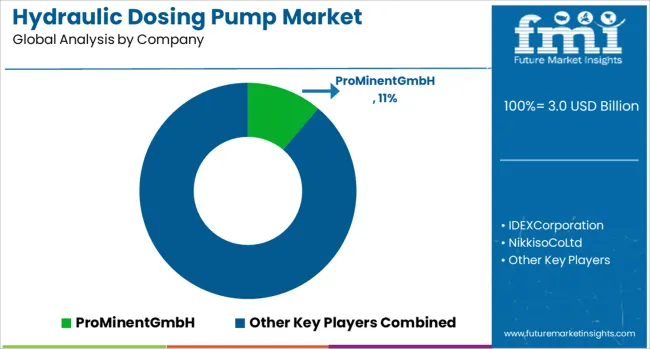
Competition in the hydraulic dosing pump market is increasingly shaped by specialization in fluid chemistry handling, automation integration, and precision metering, rather than by simple pump capacity or flow rate. Lutz-Jesco and ProMinent dominate in chemical processing and water treatment applications, differentiating themselves through proprietary stroke-control hydraulics, corrosion-resistant materials, and a modular design that enables rapid adaptation to aggressive or viscous media. Verder Group focuses on compact, high-precision dosing units for laboratory, food, and pharmaceutical applications, where volumetric accuracy and contamination control create barriers for generic suppliers. Iwaki integrates smart sensors and predictive feedback systems for continuous monitoring of dosing performance, providing industrial clients with actionable operational data that shifts the value proposition from hardware to process intelligence.
Regional and emerging players in China, India, and Southeast Asia compete on the basis of rapid customization, local compliance adaptation, and cost-effective retrofit solutions, often leveraging hybrid hydraulic-electronic controls to strike a balance between accuracy and affordability. Market rivalry is increasingly driven by ecosystem integration, where pumps are bundled with control software, monitoring dashboards, and maintenance contracts, creating lock-in for clients in water treatment, chemical, and industrial process lines. Strategic advantage is gained through service agility, chemical compatibility expertise, and the ability to integrate dosing solutions into larger automated process systems, rather than traditional head-to-head capacity or price competition.
| Item | Value |
|---|---|
| Quantitative Units | USD 3.0 Billion |
| Pump Type | Diaphragm Dosing Pumps, Plunger Dosing Pumps, and Peristaltic Dosing Pumps |
| Capacity | Medium Capacity (100–1000 ml/min), Low Capacity (100 ml/min), and High Capacity (>1000 ml/min) |
| Control Type | Fully Automatic Control, Manual Control, and Semi-Automatic Control |
| Application | Water and Wastewater Treatment, Chemical Processing, Pharmaceutical and Biotechnology, and Food and Beverage |
| Regions Covered | North America, Europe, Asia-Pacific, Latin America, Middle East & Africa |
| Country Covered | United States, Canada, Germany, France, United Kingdom, China, Japan, India, Brazil, South Africa |
| Key Companies Profiled | ProMinentGmbH, IDEXCorporation, NikkisoCoLtd, WatsonMarlowFluidTechnologyGroup, SeepexGmbH, SNPSchneiderNederlandPompenB.V., DoverCorporation, GrundfosHoldingA/S, PulsafeederInc, NetzschGroup, MiltonRoyCompany, FlowserveCorporation, LEWAGmbH, YZSystemsInc, and YamadaCorporation |
| Additional Attributes | Dollar sales by pump type (diaphragm pumps, peristaltic pumps, piston pumps, screw pumps) and end-use segments (water treatment, chemical processing, food and beverage, pharmaceuticals). Demand dynamics are influenced by the increasing need for accurate fluid handling, growing industrial automation, and environmental concerns driving the need for efficient water and chemical management. Regional trends show strong growth in North America and Europe due to regulatory pressure for accurate dosing systems in water treatment, while Asia-Pacific is expanding due to increased industrialization and infrastructure development. |
The global hydraulic dosing pump market is estimated to be valued at USD 3.0 billion in 2025.
The market size for the hydraulic dosing pump market is projected to reach USD 4.5 billion by 2035.
The hydraulic dosing pump market is expected to grow at a 4.0% CAGR between 2025 and 2035.
The key product types in hydraulic dosing pump market are diaphragm dosing pumps, plunger dosing pumps and peristaltic dosing pumps.
In terms of capacity, medium capacity (100–1000 ml/min) segment to command 49.2% share in the hydraulic dosing pump market in 2025.






Our Research Products

The "Full Research Suite" delivers actionable market intel, deep dives on markets or technologies, so clients act faster, cut risk, and unlock growth.

The Leaderboard benchmarks and ranks top vendors, classifying them as Established Leaders, Leading Challengers, or Disruptors & Challengers.

Locates where complements amplify value and substitutes erode it, forecasting net impact by horizon

We deliver granular, decision-grade intel: market sizing, 5-year forecasts, pricing, adoption, usage, revenue, and operational KPIs—plus competitor tracking, regulation, and value chains—across 60 countries broadly.

Spot the shifts before they hit your P&L. We track inflection points, adoption curves, pricing moves, and ecosystem plays to show where demand is heading, why it is changing, and what to do next across high-growth markets and disruptive tech

Real-time reads of user behavior. We track shifting priorities, perceptions of today’s and next-gen services, and provider experience, then pace how fast tech moves from trial to adoption, blending buyer, consumer, and channel inputs with social signals (#WhySwitch, #UX).

Partner with our analyst team to build a custom report designed around your business priorities. From analysing market trends to assessing competitors or crafting bespoke datasets, we tailor insights to your needs.
Supplier Intelligence
Discovery & Profiling
Capacity & Footprint
Performance & Risk
Compliance & Governance
Commercial Readiness
Who Supplies Whom
Scorecards & Shortlists
Playbooks & Docs
Category Intelligence
Definition & Scope
Demand & Use Cases
Cost Drivers
Market Structure
Supply Chain Map
Trade & Policy
Operating Norms
Deliverables
Buyer Intelligence
Account Basics
Spend & Scope
Procurement Model
Vendor Requirements
Terms & Policies
Entry Strategy
Pain Points & Triggers
Outputs
Pricing Analysis
Benchmarks
Trends
Should-Cost
Indexation
Landed Cost
Commercial Terms
Deliverables
Brand Analysis
Positioning & Value Prop
Share & Presence
Customer Evidence
Go-to-Market
Digital & Reputation
Compliance & Trust
KPIs & Gaps
Outputs
Full Research Suite comprises of:
Market outlook & trends analysis
Interviews & case studies
Strategic recommendations
Vendor profiles & capabilities analysis
5-year forecasts
8 regions and 60+ country-level data splits
Market segment data splits
12 months of continuous data updates
DELIVERED AS:
PDF EXCEL ONLINE
Hydraulic Pumps Market Growth & Outlook 2025 to 2035
Hydraulic Gear Pumps Market Size and Share Forecast Outlook 2025 to 2035
Electrohydraulic Pump Market Insights by Type, End Use, Application, and Region through 2035
Pressure Compensated Hydraulic Pump Market Size and Share Forecast Outlook 2025 to 2035
Automotive Electro-hydraulic Power Steering Pumps Market Size and Share Forecast Outlook 2025 to 2035
Hydraulic Anchor Drilling Vehicle for Mining Market Size and Share Forecast Outlook 2025 to 2035
Pump Jack Market Forecast Outlook 2025 to 2035
Pump and Dispenser Market Size and Share Forecast Outlook 2025 to 2035
Pump Testers Market Size and Share Forecast Outlook 2025 to 2035
Hydraulic Recloser Market Size and Share Forecast Outlook 2025 to 2035
Hydraulic Lifting Mobile Light Tower Market Size and Share Forecast Outlook 2025 to 2035
Hydraulic Fracturing Market Size and Share Forecast Outlook 2025 to 2035
Hydraulic Power Unit Market Size and Share Forecast Outlook 2025 to 2035
Pumpjacks Market Size and Share Forecast Outlook 2025 to 2035
Hydraulic Lifting Light Tower Market Size and Share Forecast Outlook 2025 to 2035
Pumps Market Size and Share Forecast Outlook 2025 to 2035
Pumpkin Seed Protein Market Size and Share Forecast Outlook 2025 to 2035
Hydraulic Squeeze Chute Market Size and Share Forecast Outlook 2025 to 2035
Hydraulic Cylinder Market Size and Share Forecast Outlook 2025 to 2035
Hydraulic Filters Market Size and Share Forecast Outlook 2025 to 2035

Thank you!
You will receive an email from our Business Development Manager. Please be sure to check your SPAM/JUNK folder too.
Chat With
MaRIA